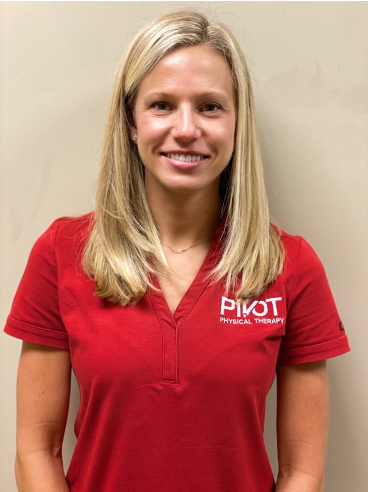Back to Care in Light of the Ongoing COVID-19 Crisis: An Interview with Brittany Rice
The ongoing COVID-19 pandemic has changed and restricted the delivery of physical and occupational therapy services for many patients in need. We recently spoke with L. Brittany Rice, PT, DPT, the Area Manager for Pivot Physical Therapy in Clayton, NC, about the impact of COVID-19 on her practice and what patients can expect when receiving care during this time.
Read the interview below:
How has the ongoing COVID-19 crisis impacted your ability to care for your patients?

Primarily, it has hindered our ability to schedule our patients quickly and efficiently, which has always been a top priority, and has become an expectation of our patients and referring providers. In an effort to social distance in our clinics, we are limiting the number of patients in our spaces at any given time. This limits appointment availability for our patients and creates a “wait list.” In addition, many clinics have been short-staffed due to exposure concerns and/or childcare challenges, which burdens our clinic operations and appointment availability even further.
We know patients are avoiding care to limit exposure to COVID-19. What are some risks associated with skipping needed physical and occupational therapy services?
I think the public often misunderstands that PT is not a gym membership. A physical therapist’s prescription, or plan of care, is carefully thought out and is specifically tailored to each individual patient. Attendance and compliance to this plan are vital for optimal results. I often compare physical therapy to a diet. If you make healthy food choices only 50% of the time, you likely won’t reach your goal. Or, if you do, it will likely take twice as long. The same is true for physical therapy. If a patient’s physical therapy prescription is for three times per week, but the patient only attends one time per week to limit potential COIVD-19 exposure, they will likely either not see the benefits at all or will improve at a very slow pace, extending the period of time which they are enduring pain or limiting participation in life activities. If the patient is post-operative, the effects could be catastrophic to the long-term outcomes of the surgery and the patient’s functional abilities.
What precautions are your practice taking to keep patients and therapists safe?
Our practices require facial coverings for patients and employees at all times. Patients are screened upon arrival at each visit using a list of questions related to possible COVID-19 exposure and symptoms. We have additional PPE (gloves, gowns, etc.) available as well as heightened disinfecting protocols for equipment, clinic furniture, and office materials. Many clinics have implemented contactless payment. For patients who do not feel safe coming into the clinic, we offer telehealth appointments via phone or video. Lastly, Pivot Physical Therapy has a COVID-19 hotline for our employees to call at any time with questions regarding COVID-19 protocols and procedures.
For patients who return to the office for in-person visits, what can they expect? What will be different?
Mandatory face coverings, a screening questionnaire at check-in, additional cleaning of all surfaces and equipment throughout the gym, office, and waiting area, and equipment spaced further apart where applicable. Some clinics are also requiring patients to wait in their car until appointment time, and some clinics will not allow friends and family to enter the clinic. Otherwise, patients can expect the same high-level, hands-on, individualized care as they would always experience.
What advice do you have for patients who may be unsure about returning to care during this time?
We are taking every precaution to continue to provide excellent care while keeping our employees and patients safe. Patient screening, cleaning, and distancing are all ways in which we are maintaining a safe environment. We also provide face coverings for patients who arrive without one. Also, there are often times in which certain clinics are generally less busy. These windows may be a good scheduling option for patients who would like to attend physical therapy when there are fewer people in the space. Ask your PT or the front desk if there are certain days or times that are historically slower in the clinic. Lastly, if a patient still feels unsure about returning to PT, we are offering telehealth PT visits. While we love to see our patients face-to-face, telehealth is a great alternative option rather than receiving no physical therapy care at all.
Even as we continue to navigate the growing health challenges imposed by the COVID-19 pandemic, therapists and the seniors who rely on their care have another great threat on the horizon. Just this week, the Centers for Medicare & Medicaid Services released the proposed rule for the 2021 Physician Fee Schedule, which detailed cuts to dozens of specialties and increased the cut to physical therapy services to 9%. This cut, coupled with a series of payment reductions in recent years, will undermine patient access and lead to negative downstream consequences for American seniors and healthcare delivery system costs.